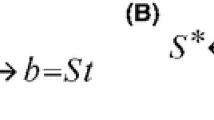Abstract
Some of the problems associated with the construction of a manifestly covariant relativistic quantum theory are discussed. A resolution of this problem is given in terms of the off mass shell classical and quantum mechanics of Stueckelberg, Horwitz and Piron. This theory contains many questions of interpretation, reaching deeply into the notions of time, localizability and causality. A proper generalization of the Maxwell theory of electromagnetic interaction, required for the well-posed formulation of dynamical problems of systems with electromagnetic interaction is discussed, and some of the significance of recently found (classical) relativistic chaotic behavior is pointed out. Many results of a technical nature have been achieved in this framework; in this paper, some of these are reviewed, but I shall concentrate on a discussion of the basic ideas and foundations of the theory.
Similar content being viewed by others
References
T. D. Newton and E. P. Wigner,Rev. Mod. Phys. 21, 400 (1949).
G. C. Hegerfeldt,Phys. Rev. D 10, 3320 (1974);Phys. Rev. Lett. 54, 2395 (1980).
See discussions in P. A. M. Dirac,Quantum Mechanics (Oxford University Press, London, 1958); C. Piron,Foundations of Quantum Physics (W. A. Benjamin, Reading, 1976).
G. C. Hegerfeldt, M. K. Hinders, B. A. Rhodes, and C. V. H. Sandri, IASSNS-HEP-90/28, April 1990.
J. R. Oppenheimer,Phys. Rev. 38, 725 (1931).
See, for example, J. S. Schwinger,Phys. Rev. 82, 664 (1951), and other fundamental papers reprinted inQuantum Electrodynamics, J. S. Schwinger, ed. (Dover, New York, 1958).
E. Prugovecki,Quantum Geometry, to appear in theFundamental Theories of Physics series (Kluwer Academic, Dordrecht), A. van der Merwe, ed.Found. Phys. 21, 93 (1991).
E. C. G. Stueckelberg,Helv. Phys. Acta 14, 372, 588 (1941);15, 23 (1942). L. P. Horwitz and C. Piron,Helv. Phys. Acta 46, 316 (1973). See also J. R. Fanchi,Phys. Rev. D 20, 308 (1979).
W. C. Schieve and L. P. Horwitz,Phys. Lett. A 156, 140 (1991), and to be published.
D. J. Taylor and J. A. Wheeler,Spacetime Physics (W. H. Freeman, San Francisco, 1966).
C. Møller,The Theory of Relativity (The Clarendon Press, Oxford, 1952), for example.
For example, S. Weinberg,Gravitation and Cosmology (Wiley, New York, 1972).
R. P. Feynman,Phys. Rev. 80, 449 (1950), App. A. See also J. S. Schwinger, Ref. 6.
Relativistic Action at a Distance: Classical and Quantum Aspects (Lecture Notes in Physics, Vol. 162), J. Llosa, ed. (Springer, Berlin, 1982);Proceedings, Workshop on Contraint's Theory and Relativistic Dynamics, Arcetri, Firenze, Italy, 1986, G. Longhi and L. Lusanna, eds. (World Scientific, Singapore, 1987).
L. P. Horwitz and F. Rohrlich,Phys. Rev. D 24, 1528 (1981), and references therein.
I. Newton,Principia (London, 1686). Andrew Motte's translation (1729) has been revised by F. Cajore,Sir Isaac Newton's Mathematical Principals of Natural Philosophy and His System of the World (University of California Press, Berkeley, 1962).
L. P. Horwitz, R. I. Arshansky, and A. C. Elitzur,Found. Phys. 18, 1159 (1988).
L. D. Landau and E. M. Lifshitz,Classical Theory of Fields (Pergamon Press, Oxford, 1975).
M. C. Land and L. P. Horwitz,Found. Phys. Lett. 21, 299 (1991).
R. P. Feynman,Phys. Rev. 76, 769 (1949).
V. A. Fock,Phys. Z. Sowjetunion 12, 404 (1937).
C. Piron, Ref. 3. See discussions in
L. P. Horwitz and F. Rotbart,Phys. Rev. D 24, 2127 (1981).
L. P. Horwitz and Y. Rabin,Lett. Nuovo Cimento 17, 501 (1976).
R. Arshansky and L. P. Horwitz,J. Math. Phys. 30, 66 and 380 (1989).
L. P. Horwitz and A. Soffer,Helv. Phys. Acta 53, 112 (1980). Completeness is proved in A. Soffer,Lett. Math. Phys. 8, 517 (1984).
R. I. Arshansky and L. P. Horwitz,J. Math. Phys. 30, 213 (1989).
C. Itzykson and J.-B. Zuber,Quantum Field Theory (McGraw-Hill, New York, 1980).
R. Arshansky and L. P. Horwitz,Phys. Rev. D 29, 2860 (1984).
P. A. M. Dirac,Rev. Mod. Phys. 21, 392 (1949).
R. Arshansky, L. P. Horwitz, and Y. Lavie,Found. Phys. 13, 1167 (1983).
R. Arshansky and L. P. Horwitz,J. Phys. A. Math. Gen. 15, L659 (1982).
E. P. Wigner,Ann. Math. 40, 149 (1939), and, for example, M. Hamermesh,Group Theory and its Applications to Physical Problems (Addison-Wesley, Reading, 1962).
R. P. Feynman,Phys. Rev. 76, 769 (1949).
J. D. Jackson,Classical Electrodynamics (Wiley, New York, 1975), 2nd edn.
L. P. Horwitz, S. Shashoua, and W. C. Schieve,Physica A161, 300 (1989).
L. P. Horwitz, W. C. Schieve, and C. Piron,Ann. Phys. 137, 306 (1981).
B. Guinot,Journées relativistes (1988) 72, Dept. de Physique Théorique, Université de Genève (1989).
C. Piron, in NATO Advanced Study Institute on Quantum Electrodynamics and Quantum Optics, Istanbul, Turkey, August 1989.
W. Minkowski,The Principle of Relativity (Dover, New York, 1923).
L. L. Foldy and S. A. Wouthuysen,Phys. Rev. 78, 29 (1950).
I thank Y. Aharonov for raising this question.
M. Usher and L. P. Horwitz,Found. Phys. Lett. 4, 289 (1991).
D. Saad, L. P. Horwitz, and R. I. Arshansky,Found. Phys. 19, 1125 (1989).
J. M. Jauch,Foundations of Quantum Mechanics (Addison-Wesley, Reading, 1968).
M. C. Land and L. P. Horwitz,Found. Phys. Lett. 4, 61 (1991).
R. I. Arshansky, Tel Aviv University Report TAUP 1479–86, unpublished.
L. D. Landau and E. M. Lifshitz,Course of Theoretical Physics, Vol. I, Mechanics, 3rd edn. (Pergamon, Oxford, 1976).
Author information
Authors and Affiliations
Additional information
On sabbatical leave from School of Physics and Astronomy, Raymond and Beverly Sackler Faculty of Exact Sciences, Tel Aviv University, Ramat Aviv, Israel.
Rights and permissions
About this article
Cite this article
Horwitz, L.P. On the definition and evolution of states in relativistic classical and quantum mechanics. Found Phys 22, 421–450 (1992). https://doi.org/10.1007/BF01883906
Received:
Issue Date:
DOI: https://doi.org/10.1007/BF01883906



